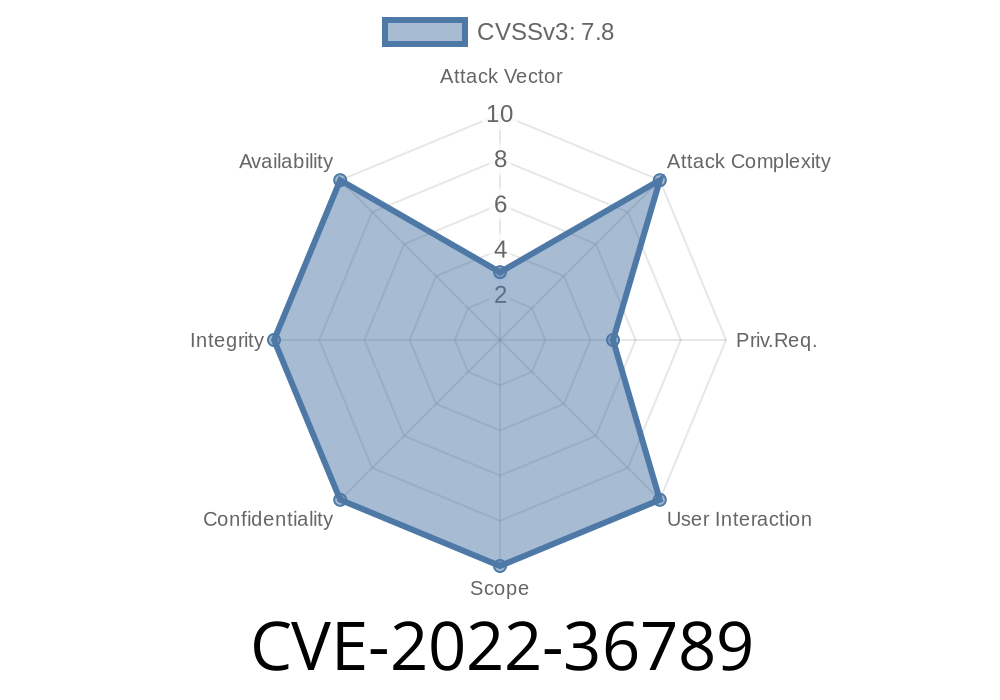In this article, we will discuss the CVE-2022-36789 vulnerability in detail, including its origin, possible attack scenarios, exploitation details, and mitigation strategies. This security vulnerability affects the BIOS firmware in some Intel(R) NUC 10 Performance Kits and Intel(R) NUC 10 Performance Mini PCs before version FNCML357.0053. An attacker with local access to the system and who possesses elevated user privileges can exploit this vulnerability to perform an escalation of privilege attack and potentially gain unauthorized control over the system.
The CVE (Common Vulnerabilities and Exposures) identifier CVE-2022-36789 was assigned to this vulnerability to uniquely identify and track it within the security community. We will use this identifier throughout the article for reference.
Original References
The vulnerability was first disclosed by Intel and has since been shared across multiple security platforms and communities. Here are some links to the original references:
1. Intel Advisory: https://www.intel.com/content/www/us/en/security-center/advisories/intel-sa-00568.html
2. NIST NVD (National Vulnerability Database): https://nvd.nist.gov/vuln/detail/CVE-2022-36789
3. MITRE CVE Entry: https://cve.mitre.org/cgi-bin/cvename.cgi?name=CVE-2022-36789
Exploit Details
The root cause of the CVE-2022-36789 vulnerability lies in the improper access control implementation within the pre-FNCML357.0053 BIOS firmware versions of the affected Intel NUC 10 devices. This vulnerability can be exploited by an attacker via local access, meaning that the attacker must have physical access to the affected system and already possess some level of elevated privileges.
To exploit this vulnerability, the attacker must use a specially crafted piece of code that can bypass the insecure access control mechanisms in place and elevate their privileges to a higher level, allowing them to compromise the system.
Here's a snippet of example code that demonstrates how an attacker could exploit this vulnerability
# Pseudo-code for demonstration purposes ONLY
# DO NOT use this code for malicious purposes
def exploit_cve_2022_36789(target_system):
# check if the target system is vulnerable
if target_system.is_vulnerable_to("CVE-2022-36789"):
# craft a payload to bypass the access control mechanisms
bypass_payload = create_bypass_payload()
# execute the payload on the target system
target_system.execute_payload(bypass_payload)
# elevate privileges of the current user
target_system.elevate_privileges()
print("Exploitation success! Your privileges have been elevated.")
else:
print("Target system is not vulnerable to CVE-2022-36789.")
Mitigation Strategies
To protect your system from the CVE-2022-36789 vulnerability, it is essential to follow the mitigation steps provided by Intel. The primary mitigation measure is to update the BIOS firmware of the affected Intel NUC 10 Performance kits and Mini PCs to version FNCML357.0053 or newer. The updated BIOS firmware resolves the improper access control issue, making it significantly harder for an attacker to exploit.
You can download the latest BIOS firmware update for your specific Intel NUC model from Intel's official website: https://downloadcenter.intel.com/
In addition to updating the BIOS firmware, it is also essential to practice good security hygiene. Some recommendations include:
Conclusion
The CVE-2022-36789 vulnerability is a critical security issue that impacts certain Intel NUC 10 devices, allowing an attacker to escalate their privileges and potentially gain unauthorized control over the system. By understanding the details surrounding this vulnerability, you can take the necessary steps to mitigate the risk and protect your systems. Regularly updating your BIOS firmware, along with practicing good security hygiene, can significantly reduce the likelihood of a successful exploitation attempt.
Timeline
Published on: 11/11/2022 16:15:00 UTC
Last modified on: 11/16/2022 16:58:00 UTC
